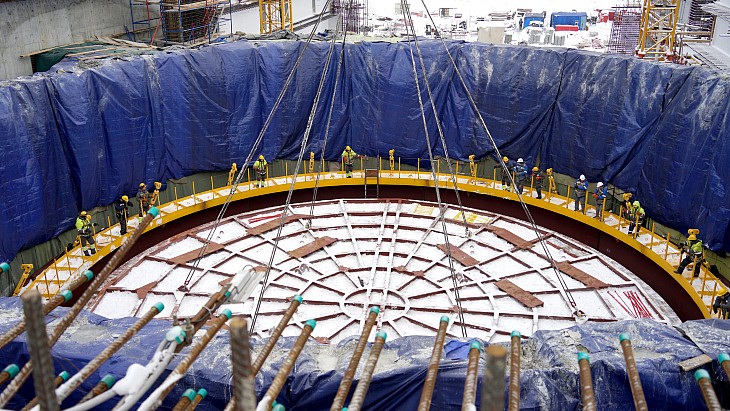The reactor base plate, weighing 165 tonnes, was delivered to the site in two pieces in September 2022 and has been assembled on site. It is designed to equalise the loads on the foundation from the elements of the reactor vessel. The pouring of concrete for the foundation slab was completed in August 2021. The first part of the reactor vessel, the lower tier of the containment, has also been loaded into the reactor shaft.
The lead-cooled BREST-OD-300 fast reactor is part of Rosatom's Proryv, or Breakthrough, project to enable a closed nuclear fuel cycle. The 300 MWe unit will be the main facility of the Pilot Demonstration Energy Complex at the Siberian Chemical Combine site. The complex will demonstrate an on-site closed nuclear fuel cycle with a facility for the fabrication/re-fabrication of mixed uranium-plutonium nitride nuclear fuel, as well as a used fuel reprocessing facility.
A fuel production facility and an irradiated fuel reprocessing module are scheduled to be built by 2023 and 2024, respectively, while the BREST-OD-300 reactor is expected to start operation in 2026.
Vadim Lemekhov, chief designer of the BREST-OD-300 reactor unit and the project team, said: "We have started installation of the world’s first lead-cooled fast reactor, the fourth generation reactor BREST-OD-300. Unlike traditional light-water VVER thermal reactors, BREST has an integral layout. Its vessel is not an all-metal structure like the VVER, but a metal-concrete structure with metal cavities to accommodate the primary circuit equipment. The space between the cavities should be gradually filled with concrete filler during construction. In addition, the BREST vessel is larger in size, it can be delivered only in parts, and the final assembly is possible only at the construction site."
Fast reactors such as BREST-OD-300 are able to use secondary products from the traditional reactors' fuel cycle, such as plutonium, for their own fuel, as well as being to produce more potential fuel than they consume. The reactor will provide itself with its main energy component - plutonium-239 - by reproducing it from the isotope uranium-238, Russia's fuel company, TVEL, says. As about 99% of natural uranium is uranium-238, Rosatom says "the introduction of such technologies will increase exponentially the efficiency of natural uranium".
According to the World Nuclear Association information paper on fast neutron reactors, "the BREST fast neutron reactor, of 700 MWt, 300 MWe has lead as the primary coolant, at 540°C, and supercritical steam generators. It is inherently safe and uses a mixed uranium and plutonium nitride fuel... no weapons-grade plutonium can be produced, since there is no uranium blanket - all the breeding occurs in the core ... fuel cycle is quoted at 5-6 years with partial refuelling at about 10 months. The initial cores can comprise plutonium and spent fuel - hence loaded with fission products, and radiologically 'hot'. Subsequently, any surplus plutonium, which is not in pure form, can be used as the cores of new reactors. Used fuel can be recycled indefinitely, with onsite facilities. The nitride fuel has been successfully tested in the BN-600 reactor to a burn-up of 7.4%".
Initial operation of the demonstration unit will be focused on performance and after 10 years or so it will be commercially oriented. The plan has been that if it is successful as a 300 MWe unit, a 1200 MWe (2800 MWt) version will follow - the BR-1200.





_53514_33880.jpg)


_91467.jpg)





